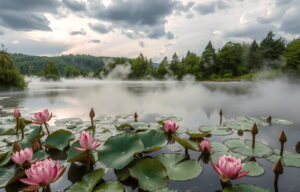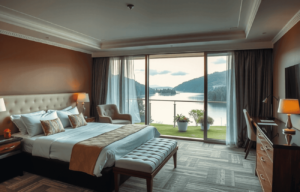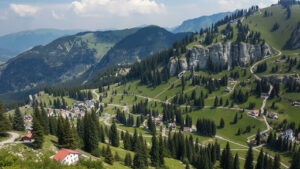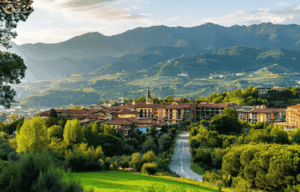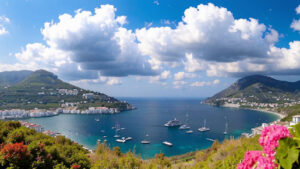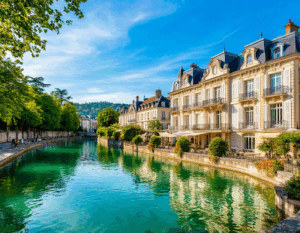Thermal Spa Treatment
Thermal therapy is a form of restorative treatment that harnesses the therapeutic effects of natural mineral waters on the body. Medical indications for visiting thermal resorts include musculoskeletal disorders, post-traumatic rehabilitation, chronic joint inflammation, as well as skin and nervous system conditions. High concentrations of minerals—such as sulfur, sodium, calcium, radon, or silicic acid—stimulate regenerative processes, improve microcirculation, and reduce systemic inflammation.
For a sustainable therapeutic effect, it is recommended to stay at a thermal resort for at least 10 days. During this period, treatments produce cumulative benefits, and the body gradually adapts to the mineral-rich waters.
The best time to visit is during the shoulder seasons — spring and autumn. At these times, there is no risk of overheating or excessive strain on the cardiovascular system, and water temperatures (ranging from 32 °C to 42 °C / 90 °F to 108 °F) are comfortably tolerated. Autumn visits are particularly beneficial for strengthening immunity ahead of winter, while spring trips help overcome chronic fatigue and vitamin deficiencies.
While thermal spa treatments do not replace medication, they enhance its effects, reduce the need for frequent painkillers, and accelerate recovery. This is why thermal resorts are included in medical rehabilitation programs across many European countries.
About Thermal Springs
Water becomes thermal after a long journey underground. As it penetrates deep into the Earth, it naturally heats up and absorbs minerals from subterranean rocks. Nature has two ways of warming this water:
- Volcanic activity: In volcanic regions, springs are heated by magma close to the surface.
- Geothermal gradient: In non-volcanic areas, water warms gradually due to the increase in temperature with depth, caused by the Earth’s crust. The deeper the water flows toward the Earth’s center, the hotter it becomes.
However, to be classified as a thermal spring, the water must not only be hot but also possess certain qualities:
- Mineral composition: As water passes through deep layers, it dissolves minerals and develops a unique chemical profile.
- Therapeutic effect: The combination of heat and mineral content influences metabolism, circulation, joints, and the nervous system, making thermal springs therapeutic rather than merely hot.
Health Benefits of Thermal Springs
Each thermal spring has a unique mineral composition, shaped hundreds of meters underground and determined by regional geology. Some waters are rich in sulfur, others in radon or carbon dioxide. The specific combination of minerals determines their therapeutic effects and the conditions they are best suited to treat.
Common types of thermal waters and their benefits:
Sulfur waters
Hydrogen sulfide (in low concentrations) improves microcirculation and tissue metabolism, activating enzymatic processes. Cells absorb oxygen and nutrients more efficiently, accelerating recovery of skin, muscles, and joints. Sulfur waters are particularly beneficial for chronic dermatoses, osteoarthritis, rheumatism, and peripheral circulatory disorders. In Italy, they are also used for inhalation therapy in chronic bronchitis and respiratory inflammation.
Notable sulfur resorts are found in Italy, Hungary, Montenegro, and France. Miskolc-Tapolca in Hungary is unique, offering baths directly in natural caves, where the waters gently affect joints and the nervous system while the cave atmosphere enhances relaxation.
Radon waters
Radon is an inert gas that, in low doses, provides mild anti-inflammatory and analgesic effects. It regulates nervous system activity, relieves chronic pain and stress, and supports post-injury recovery. Recent studies also show that radon baths improve endocrine function and reduce cortisol levels.
Famous radon resorts are located in the Czech Republic, Germany, and Austria. The Jachymov spa in the Czech Republic has been using radon waters since the early 20th century. Doctors observed faster recovery and reduced pain long before the mechanisms were scientifically understood. Later research confirmed that low-dose radon indeed reduces inflammation and triggers cellular regeneration.
Carbonated waters
Carbonated mineral waters are saturated with carbon dioxide, which, upon contact with the skin, stimulates capillary blood circulation and gently dilates blood vessels. This improves the delivery of oxygen to tissues, lowers blood pressure, and normalizes the functioning of the heart. They are recommended for cardiovascular diseases, metabolic disorders, diabetes, and chronic fatigue syndrome.
Interestingly, carbonated waters can be used not only in the form of baths. For example, the unique composition of the carbonated waters of Karlovy Vary is actively used for drinking purposes to treat and prevent liver, stomach, and biliary tract conditions, while improving digestion and normalizing gastric acidity.
Carbonated springs are widely found in the Czech Republic, Slovakia, and Austria.
Iodine-bromine waters
A rare but highly valuable type of thermal water. Iodine and bromine have calming effects on the nervous system, support thyroid function, and stimulate metabolism. Iodine strengthens blood vessels and balances hormones, while bromine gently reduces anxiety and improves sleep.
These baths are recommended for thyroid disorders, menstrual irregularities, chronic pelvic inflammation, neuroses, and stress recovery. They also benefit the skin by accelerating tissue regeneration and improving microcirculation.
Resorts with iodine-bromine waters can be found in the Czech Republic, France, and Italy, where mineral waters combined with a seaside climate enhance treatment effects.
For convenience, we have prepared a brief table summarizing the indications and contraindications for different types of thermal springs.
| Water Type | Main Indications | Contraindications |
| Sulfur Waters | Chronic dermatoses (psoriasis, eczema), osteoarthritis, rheumatism, peripheral vascular disorders, bronchitis | Acute inflammatory conditions, liver and kidney diseases, pregnancy, severe cardiovascular insufficiency |
| Radon Waters | Musculoskeletal disorders, neuralgia, endocrine disorders, stress-related conditions, chronic pain | Cancer, pregnancy, anemia, childhood, pronounced hypotension |
| Carbonated Waters | Cardiovascular diseases, hypertension, diabetes, metabolic disorders, chronic fatigue syndrome | Acute inflammatory conditions, pronounced hypotension, decompensated cardiovascular diseases |
| Iodine-Bromine Waters | Thyroid disorders (hypothyroidism), chronic gynecological conditions, joint pathologies, nervous system disorders | Hyperthyroidism, allergy to iodine or bromine, acute skin infections |
Regardless of the specific mineral composition, hot springs provide a pronounced relaxing effect:
- The warmth of the water relieves muscle spasms and reduces pain
- Immersion eases joint stress and facilitates movement
- Mineral components strengthen the skin and blood vessels
- Treatments normalize sleep, lower stress levels, and enhance the body’s adaptation to physical loads
Our experts will help select a resort with the most suitable thermal water composition for each individual case. This selection carefully considers the diagnosis, treatment goals, possible contraindications, and personal preferences of the client. Only with this approach can the stay deliver the maximum therapeutic effect.
Thermal Resort Treatment Programs
At the thermal resorts we partner with, relaxation and treatment are combined into a single program. From the first days, guests undergo a medical consultation: a doctor assesses their health, reviews test results, and determines the optimal therapy plan. This approach ensures the properties of the specific spring are fully utilized while avoiding overstrain.
Treatments are centered around thermal waters. Most commonly, these include bathing in pools or private baths, which reduce inflammation, relax muscles, and improve joint mobility. At resorts with drinking mineral waters, guests follow water-based programs to restore the function of the stomach, liver, and biliary tract. In locations where waters contain volatile microelements, inhalation therapies are used for respiratory health. Additional treatments may include mud applications, contrast wraps, and hydro-massages.
Thermal therapy rarely relies solely on water. Programs often include:
- Physiotherapy procedures
- Massages
- Pool exercises
- Therapeutic gymnastics
- Yoga or breathing practices
Nutrition is an essential part of restorative stays. Resorts provide specialized dietary menus or develop individualized meal plans with a nutritionist. This comprehensive approach enhances the effects of the mineral waters and helps consolidate the results.
The average duration of a thermal therapy program ranges from one to three weeks. Generally, this is sufficient to reduce inflammation, restore energy, normalize sleep, and improve overall well-being.
Top Countries for Thermal Wellness
Thermal springs exist worldwide, but Europe is considered the center of balneological tourism. Here, a mild climate, ancient healing traditions, and modern medical technologies converge. We have highlighted five countries particularly popular with our clients, known for their natural resources, resort infrastructure, and diverse wellness programs.
Czech Republic
The Czech Republic is famous for its mineral and carbonated water resorts. The “Golden Triangle of Health” — Karlovy Vary, Marianske Lazne, and Frantiskovy Lazne — is surrounded by hills and forests. The springs are widely used in local facilities and health centers for baths, inhalations, and drinking cures.
Czech waters are particularly valued for their gentle therapeutic effects on the gastrointestinal tract and metabolism. Programs are prescribed for liver, pancreas, gastritis, and diabetes. Drinking cures are conducted strictly under medical supervision, as each spring has a unique composition and specific indications.
Hungary
Hungary has more than a thousand thermal springs. Hungarian waters are highly mineralized, containing sulfur, magnesium, and bicarbonates. They are well-regarded for treating joint and spinal conditions, as well as chronic skin problems, including psoriasis and eczema.
Many baths are not merely therapeutic complexes but historic buildings with unique architecture. Old halls with mosaics and vaulted ceilings create a special atmosphere during treatments.
Hungarian wellness programs focus particularly on musculoskeletal rehabilitation and post-injury recovery. Medical plans typically include baths, underwater spinal traction, mud applications, breathing exercises, and therapeutic gymnastics.
Italy
Italy is one of the most popular destinations for thermal wellness in Europe, boasting over 400 thermal springs, many of which are officially recognized for their healing properties and monitored by the Ministry of Health. Tuscany, Ischia Island, Abano Terme, and Saturnia are renowned for their gentle sulfur and calcium waters, beneficial for joint disorders, skin conditions, and metabolic imbalances.
Italian spa treatments are often complemented by mud therapy, seawater procedures, and unique vinotherapy (rarely found elsewhere). These treatments improve microcirculation and skin condition, making them ideal for gentle anti-aging care.
Germany
Germany has over 350 recognized balneological resorts. Each spring varies significantly in composition — some are rich in carbon dioxide, others in sulfur or radon — allowing guests to choose a resort tailored to their health profile.
German thermal springs are used for joint disorders, neurological conditions, metabolic disturbances, and cardiovascular problems. Many resorts specialize in post-trauma and post-surgery rehabilitation. Programs include baths, drinking cures, modern physiotherapy, massages, kinesitherapy, and therapeutic exercises.
Wellness stays in Germany are distinguished by a high level of medical supervision. Licensed clinics operate on-site, and all treatments are prescribed by qualified doctors.
France
France is also renowned for its picturesque thermal resorts, with Vichy being the most famous. Included in the UNESCO World Heritage list, it features 15 mineral springs with varied chemical compositions, six of which are used for drinking cures. Vichy waters are prescribed for stomach, liver, pancreas, and metabolic disorders.
France is also known for its thalassotherapy centers along the Atlantic coast and in Brittany, using seawater, algae, and mud. The mild maritime climate enhances treatment effects, making this format especially suitable for respiratory conditions, chronic stress, and metabolic disorders.
Hospitality MedService collaborates exclusively with verified thermal resorts, clinics, and hotels that provide all conditions for high-quality treatment and wellness. We will help select the best destination and program based on the diagnosis, treatment goals, and personal preferences.
